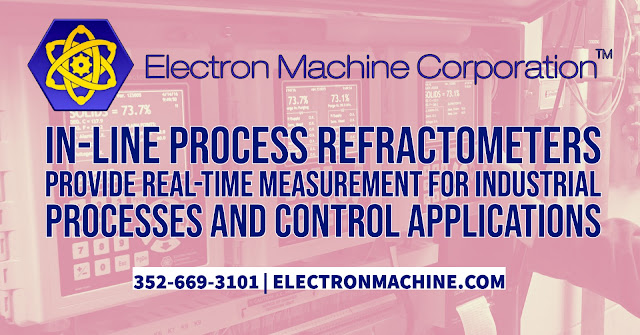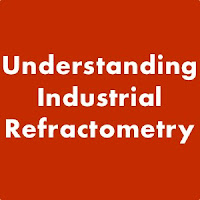This blog focuses on industrial, inline process refractometers and their use in industrial applications. Refractometry is used to measure the refractive index of a substance in order to determine its composition or purity. Posts include information on theory, construction, installation, new products and new markets.
Electron Machine Corporation | Umatilla, FL | PHONE: 352-669-3101 | ElectronMachine.com
In-line Process Refractometer Applications
Demonstration of Measuring °Brix in Fruit Juices with an Inline Process Refractometer
Are you a juice manufacturer that wants better quality control while reducing cost? Stay tuned to see how this instrument can help you out.
Welcome to Electron Machine Corporation, manufacturer of the world's most rugged refractometer, found in various industries across the globe.
The next series of videos will highlight some of the most common applications for Electron Machine refractometers.
Typically installed in a pipeline, the MPR E-Scan is set up here as a piece of demonstration equipment. In this demo, a static cup measures a variety of juices. The juice industry uses refractometers to make sure they have a consistent product by concentrating or blending it. You may mix different types of orange juices to keep the same flavor and taste throughout the year.
You also may concentrate the liquid, such as you find in a frozen can of apple juice. The refractometer ensures it stays consistent so that when you add three or four cans of water to it, it tastes as it should. In other cases, they sometimes add sugar to the juices to control the °Brix content, and that's where the refractometer excels.
Hopefully, you'll enjoy this quick little look into what the refractometer actually can do and how it measures orange juice. Stay tuned for the next series of videos. We'll highlight another product for the refractometer to measure.
Electron Machine Corporation
https://electronmachine.com
+1 352-669-3101
Electron Machine is Exhibiting at Chem Show 2019
The Chem Show is where engineers, plant managers and other CPI personnel come together to see the latest equipment & technology, meet product experts, and discover new ways to optimize their plant operations. Bringing together thousands of industry professionals and more than 270 exhibiting companies, the Show is the largest North American event exclusively focused on the processing of fluids, powders and gases. Held every odd year since 1915, the Chem Show has a proven track record of helping the CPI meet the ongoing demand for faster, smarter, cleaner, and more efficient processing facilities. Electron Machine is very excited to be exhibiting our line of process refractometers this year.
The Chem Show is held at the Javits Convention Center in Manhattan.
To learn more about our products and exhibit, visit this link.
To see our booth location, follow this link.
If you plan on attending the Chem Show, please make a point of stopping by and saying hello.
What Is An Inline Process Refractometer?
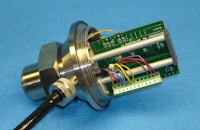 |
| Inline sensing head |
Inline process refractometers are made up of three main components:
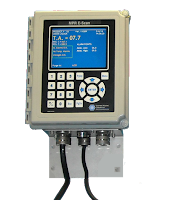 |
| Control console |
- The inline sensing head, which is inserted to a pipe and is exposed the the product for direct measurement. The sensor is connected by a cable to the second main component, the control console.
- The control console, which houses the display, electronics, power supply and output connections. Both the sensor and the control module are designed for high accuracy and precise control. Their housing and cabling are often specialized for use in varying extreme conditions and very demanding environments.
- The process adapter, which connects the sensor mechanically to the process piping. Adapters are configured for the pipe size and application they are used on and are available in many configurations. Some of the more common adapter options are:
- Lined - For extremely corrosive applications.
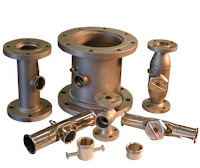
Mounting adapters - Inline - For most applications with pipeline sizes less than 2”.
- Isolation - For critical process lines that cannot normally be shut down.
- Sanitary - For applications on a sanitary pipeline.
- Spool - For most applications with pipeline sizes greater than 2”.
- Vessel - For applications where the sensing head is to be mounted directly onto a vessel or vacuum pan.
- Weld-in - For economical mounting.
Important Process Instrumentation Terminology
Accuracy: The closeness of an indicator or reading of a measurement device to the actual value of the quantity being measured; usually expressed as ± percent of the full scale output or reading.
Drift: The change in output or set point value over long periods of time due to such factors as temperature, voltage, and time.
Hysteresis: The difference in output after a full cycle in which the input value approaches the reference point (conditions) with increasing, then decreasing values or vice versa; it is measured by decreasing the input to one extreme (minimum or maximum value), then to the other extreme, then returning the input to the reference (starting) value.
Linearity: How closely the output of a sensor approximates a straight line when the applied input is linear.
Noise: An unwanted electrical interference on signal wires.
Nonlinearity: The difference between the actual deflection curve of a unit and a straight line drawn between the upper and lower range terminal values of the deflection, expressed as a percentage of full range deflection.
Precision: The degree of agreement between a number of independent observations of the same physical quantity obtained under the same conditions.
Repeatability: The ability of a sensor to reproduce output readings when the same input value is applied to it consecutively under the same conditions.
Resolution: The smallest detectable increment of measurement.
Sensitivity: The minimum change in input signal to which an instrument can respond.
Stability: The ability of an instrument to provide consistent output over an extended
period during which a constant input is applied.
Zero balance: The ability of the transducer to output a value of zero at the electronic null
point.
In-Line Process Refractometers
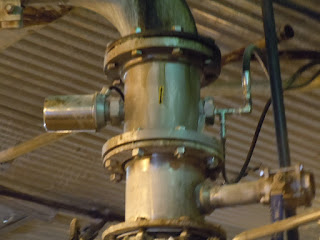 |
| In-line Process refractometer sensor in spool-piece. |
In-line Process refractometers save labor costs, streamline the manufacturing process, and improve quality by detecting inconsistencies in a product early in the production phase.
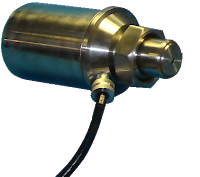 |
| Process refractometer sensor. |
The control module includes programming for a wide variety of commonly required features, capabilities, and options that can be adapted to a customer’s requirements. This microprocessor control also allows for custom programming for specialized needs.
 |
| Process refractometer control module. |
The sensor can be supplied with a multitude of mounting and cleaning options. Cleaning options include hand cleaning systems, high pressure cleaning systems, and steam cleaning systems. Mounting adapter options include lined adapters, spool-piece adapters, sanitary connection adapters, and weld-in adapters.
Not to be confused with their distant relatives - the handheld digital or analog laboratory refractometer - today's rugged, industrial in-line process refractometers provides continuous process management for large-scale facilities giving them the ability to increase product yield, maintain consistency, and eliminate waste.
Measuring Brix
 |
| Degrees Brix is the unit used to determine sugar content in a solution. |
Sucrose and other sweeteners allow for members of the food and beverage industry to create unique recipes for their products. However, a sucrose solution dissolved in water will return different Brix values than a soda because other elements in the process impact the Brix reading. To account for these shifting variables, a Brix value can be measured through either density or refractive index. Specific control parameters need to be established prior to measuring these solutions with refractometers, thus causing the term “Refractive Brix” to be used when comparing samples against results obtained via different calculation methods. Along with the numerical sugar concentration of a particular product, a product’s sugar concentration correlates to the product’s sweetness, giving controllers the ability to ensure repeatability in their process.
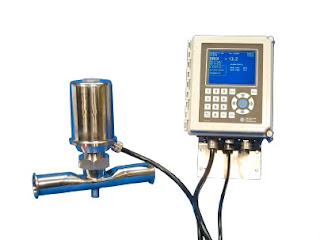 |
| Process refractometers monitor and control the quality of products containing sugar by measuring Brix. |
Electron Machine Corporation
https://electronmachine.com
352-669-3101
Bleaching of Pulp in the Paper Making Process
Typically, the pulp is treated with each chemical in a separate stage. Each stage includes a tower, where the bleaching occurs; a washer, which removes bleaching chemicals and dissolved lignins from the pulp prior to entering the next stage; and a seal tank, which collects the washer effluent to be used as wash water in other stages or to be sewered. Bleaching processes use various combinations of chemical stages called bleaching sequences.
The first stage in the bleaching process is the chlorination stage, whose primary function is to further delignify the pulp. Chlorine reacts with lignin to form compounds that are water-soluble or soluble in an alkaline medium, which aids in delignifying the pulp before it proceeds to the next bleaching stage.
The next stage after chlorination is typically the extraction stage. This stage and the remaining stages serve to bleach and whiten the delignified pulp. The extraction stage removes the chlorinated and oxidized lignin by solubilization in a caustic solution.
Chlorine dioxide is often used in bleaching, either in the chlorination stage (as a substitute for some of the chlorine usage - chlorine dioxide substitution) or as an additional chlorine dioxide stage. Chlorine dioxide has 2.63 times greater oxidizing power (on a pound per pound basis) than chlorine and is used for nearly all high brightness pulps.
The next stage is the actual bleaching stage. Hypochlorite is a true bleaching agent that destroys certain chromophobic groups of lignin. It also attacks the pulp so high cellulose degradation occurs in Kraft pulp. Application of hypochlorite to Kraft pulp is usually used only as an intermediate stage of the sequence or to produce semi-bleached pulps. In the bleach process, residual chlorine must be removed through washing in vacuum washers.
Air Toxic Sources and Emission
Estimation Methods
Introduction to Industrial Instrumentation
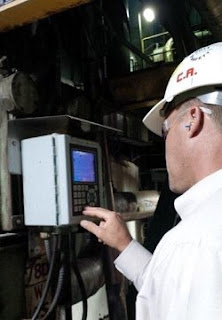 |
| Engineer adjusting a process controller measuring the refractive index of a process. |
The first step, naturally, is measurement. If we can’t measure something, it is really pointless to try to control it. This “something” usually takes one of the following forms in industry:
- Fluid pressure
- Fluid flow rate
- The temperature of an object
- Fluid volume stored in a vessel
- Chemical concentration
- Machine position, motion, or acceleration
- Physical dimension(s) of an object
- Count (inventory) of objects
- Electrical voltage, current, or resistance
- Refractive Index
This final control device usually takes one of the following forms:
- Control valve (for throttling the flow rate of a fluid)
- Electric motor
- Electric heater
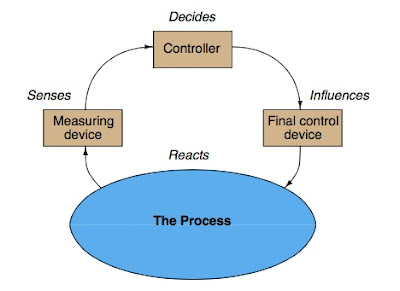 |
| Process control loop |
Industrial measurement and control systems have their own unique terms and standards. Here are some common instrumentation terms and their definitions:
Process: The physical system we are attempting to control or measure. Examples: water filtration system, molten metal casting system, steam boiler, oil refinery unit, power generation unit.
Process Variable, or PV: The specific quantity we are measuring in a process. Examples: pressure, level, temperature, flow, electrical conductivity, pH, position, speed, vibration.
Setpoint, or SP: The value at which we desire the process variable to be maintained at. In other words, the “target” value for the process variable.
Primary Sensing Element, or PSE: A device directly sensing the process variable and translating that sensed quantity into an analog representation (electrical voltage, current, resistance; mechanical force, motion, etc.). Examples: thermocouple, thermistor, bourdon tube, microphone, potentiometer, electrochemical cell, accelerometer.
 |
| Example of a transducer. In this case, a Refractive Index transducer. |
instrumentation signal, and/or performing some sort of processing on that signal. Often referred to as a converter and sometimes as a “relay.” Examples: I/P converter (converts 4- 20 mA electric signal into 3-15 PSI pneumatic signal), P/I converter (converts 3-15 PSI pneumatic signal into 4-20 mA electric signal), square-root extractor (calculates the square root of the input signal).
Note: in general science parlance, a “transducer” is any device converting one form of energy into another, such as a microphone or a thermocouple. In industrial instrumentation, however, we generally use “primary sensing element” to describe this concept and reserve the word “transducer” to specifically refer to a conversion device for standardized instrumentation signals.
Transmitter: A device translating the signal produced by a primary sensing element (PSE) into a standardized instrumentation signal such as 3-15 PSI air pressure, 4-20 mA DC electric current, Fieldbus digital signal packet, etc., which may then be conveyed to an indicating device, a controlling device, or both.
 |
| Example of a transmitter and/or controller. In this case, refractive index signal conditioning electronics to modify the transducer signal, and optionally, provide a control output to a final control element. |
measurement deemed to be 0% and 100% of a transmitter’s calibrated range. For example, if a temperature transmitter is calibrated to measure a range of temperature starting at 300 degrees Celsius and ending at 500 degrees Celsius, its LRV would be 300
Zero and Span: alternative descriptions to LRV and URV for the 0% and 100% points of an instrument’s calibrated range. “Zero” refers to the beginning-point of an instrument’s range (equivalent to LRV), while “span” refers to the width of its range (URV − LRV). For example, if a temperature transmitter is calibrated to measure a range of temperature starting at 300 degrees Celsius and ending at 500 degrees Celsius, its zero would be 300 oC and its span would be 200 oC.
Controller: A device receiving a process variable (PV) signal from a primary sensing element (PSE) or transmitter, comparing that signal to the desired value (called the setpoint) for that process variable, and calculating an appropriate output signal value to be sent to a final control element (FCE) such as an electric motor or control valve.
Final Control Element, or FCE: A device receiving the signal output by a controller to directly influence the process. Examples: variable-speed electric motor, control valve, electric heater.
Manipulated Variable, or MV: The quantity in a process we adjust or otherwise manipulate in order to influence the process variable (PV). Also used to describe the output signal generated by a controller; i.e. the signal commanding (“manipulating”) the final control element to influence the process.
Reprinted from Lessons In Industrial Instrumentation by Tony R. Kuphaldt under the terms and conditions of the Creative Commons Attribution 4.0 International Public License.
Don't Forget Customer Support and Technical Support When Buying Process Instruments
 |
| Make sure your vendor's Customer Service and Tech Support are knowledgeable, experienced, and ENTHUSIASTIC. |
When choosing a vendor for process instrumentation (industrial refractometers for instance), it's imperative to include an evaluation of the vendor's Technical Support and Customer Support infrastructure. Realizing what these professionals have to contribute, and taking advantage of their knowledge and talent, will save time and money, and greatly contribute to a successful project outcome.
Understanding Why Technical Support and Customer Support are Critical
It's all about two things:- Experience
- Attitude
Experience
"If you think it's expensive to hire a professional to do the job, wait until you hire an amateur." Red Adair
By the nature of their job, Customer Service personnel are current on new products, their capabilities and their proper application. Unlike anecdotal information available on the Web, support personnel have first hand knowledge and hands-on experience. They've seen successful (and unsuccessful) product implementation scenarios and are eager to share. A brief discussion about your application with a specialist will guide you toward selecting the best equipment for the requirement. Also, because they are exposed to so many different applications and situations, Customer/Tech Support personnel are a wealth of ancillary application knowledge.
As a project engineer, you may be treading on fresh ground regarding some aspects of fully understanding the project you're working on. You may not have a full grasp on how to handle a particular challenge presented by the application. Calling upon a source with past exposure and experience to your current application prior to product selection will provide a very real, and very valuable benefit.
Attitude:
"Customer service is not a department, it’s everyone’s job." Anonymous
Choose a company that places a huge emphasis on customer service and do some due-diligence. Determine if they're merely providing lip service, or if extreme customer service oozes from the company pores.
As an engineer who designs or manufactures a product or process, it's strongly recommended you make the effort to research, contact, and get a first-hand feel for your prospective vendor's Customer and Technical Support Team. Learn about their product and application knowledge, their experience and their commitment to excellence. Taking the time to do this will raise the likelihood that your project will come in on time, on budget and shine brightly upon you.
Industrial Refractive Index Transmitters
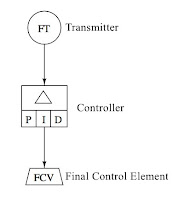 |
| Example flow loop diagram showing role of transmitter. |
Transmitters are available for almost every measured parameter in process control, and often referred to according to the process condition which they measure.
The refractive index determines how much light is bent, or refracted, when entering a material. When light moves from one medium to another, it changes direction (refracted). This change in the direction of the light can be measured and applied to properties of the material.
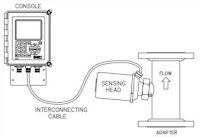 |
| Example of Industrial Refractive Indextransmitter/controller. Can act as transmitter alone, or with optional PID control functions. |
Many transmitters are provided with higher order functions in addition to merely converting an input signal to an output signal. On board displays, keypads, Bluetooth connectivity, and a host of industry standard communication protocols can also be had as an integral part of many process transmitters. Other functions that provide alarm or safety action are more frequently part of the transmitter package, as well.
Industrial Refractive Index transmitters have evolved from simple signal conversion devices to higher functioning, efficient, easy to apply and maintain instruments utilized for providing input to process control systems.
For more information on Industrial Refractive Index transmitters visit Electron Machine at http://www.electronmachine.com or call 352-669-3101.
New Electron Machine Marketing Video
Industrial Refractometry: The Very Basics
If you’ve ever cracked open a crisp, cold beer on a Sunday, sampled a great wine, or asked yourself, “why does this soda taste so good?” you’ve had experience with what the process control industry calls “industrial refractometry.” Pink Floyd’s album cover for Dark Side of the Moon, where a beam of light hits a prism at a certain angle and then exits the other side in multiple colors, illustrates a core component of refractometry. Refractometry measures the speed at which light passes through an object.
Here’s how evaluating a substance with a refractometer works: a substance is placed on top of a prism. Then, a beam of light shines through the prism and reflects through the substance. The refractometer compares how much slower (or faster) light travels through the object compared to the speed of light through air. The comparison allows the evaluator to determine qualitative aspects of the substance, such as the density or concentration. For standardization purposes, the speed at which light passes through air has a refractive index (RI) value of 1. If a substance has an RI value of 1.16, light travels 16% quicker through air compared to the substance on the prism. Depending on the color and temperature of the reflected light, even more qualitative characteristics of the substance can be determined.
 |
| Electron Machine Inline Industrial Refractometer |
While the process won’t always help determine what exactly a substance is (different substances can have the same RI values), refractometry is essential in determining how something is. If a corporation knows the RI value of a liquid product, they can ensure each iteration of said product is precisely made, quantitatively and qualitatively. When two substances are being combined to create one resulting substance, refractometry can show exactly how close the combined substance is to being an accurate fusion.
Overall, refractometry is used by industrial companies as a control method. Industry professionals use refractometers to perform evaluations; these refractometers range from small, hand-held devices to full-powered, computer-controlled precision machines which measure the quality of every product coming out of on an assembly line. Refractometry is an objective way to prove standards are being met while achieving production excellence, making refractometry an extremely valuable tool for industrially geared businesses of almost every size.
So, the next time you want to combine coffee and creamer, if you know the refractive value of the best cup of coffee, you could use your own refractometer to measure how close you are to the perfect morning blend!
MPR- E-Scan Inline Refractometer Settings and Readings Overview
The video below provides and overview of zeroing, setting, and reading the refractometer.
